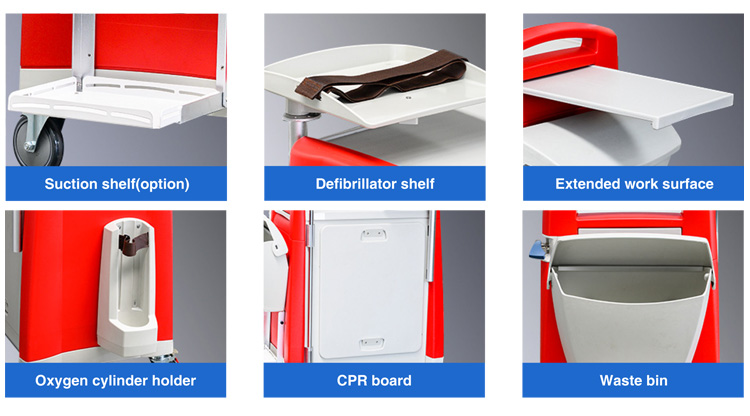Medik Blog
What is a medical cart?
A medical cart is a movable piece of equipment used in healthcare facilities to store, transport, and dispense medicines, medical supplies, and emergency equipment. Medical carts come in various sizes, shapes, and configurations depending on the specific needs of the healthcare facility.
Importance of medical carts in healthcare settings
Medical carts are convenient and organized thus providing secure access to narcotics, and other medical necessities at the time when you need them the most. This improves staff efficiency and better patient treatment. The medical carts are designed in a way that they can easily manage everyday rigors and meet the needs of every department.
Types of Medical Carts
Emergency crash carts provide organized, portable storage with secure, easy access to critical-care supplies in emergency situations. The configuration of Emergency crash carts may vary, but most will be a waist high or chest-high wheeled carts with many drawers. Many hospitals will keep a defibrillator and heart monitor on top of the crash cart since these devices are also needed in most codes.
Anesthesia Carts are designed with a synergy of function and technology to meet the requirements for anesthesia storage, organization and security. Anesthesia carts are essential equipment for operating rooms within a hospital. Anesthesia carts provide storage for critical supplies and equipment required for patient procedures and surgeries.
Isolation carts are used to transport and store supplies and equipment used for patients who are in isolation due to infectious diseases. They are designed to prevent the spread of infection by providing a barrier between the patient and the surrounding environment.
Medication carts are used to store and transport medications in healthcare settings. They are designed with drawers and compartments to organize and secure medications, and they often have locking mechanisms to ensure the security and safety of the medications.
Medical Computer Carts are designed for clinical settings. They eliminate back-breaking repetition when transporting equipment in examination rooms.
F. Medical Supply Carts
Medical supply carts are used to transport and store general medical supplies and equipment throughout healthcare facilities. They may include items such as gloves, gowns, cleaning supplies, and other general medical equipment needed in patient care areas.
Each type of medical cart serves a specific purpose and is designed to meet the unique needs of healthcare settings. By using the appropriate medical cart, healthcare workers can efficiently provide high-quality patient care while maintaining a safe and organized environment.
Features of Medical Carts
A. Construction materials
Medical carts are typically made from durable materials like stainless steel, aluminum, or plastic. The construction materials used depend on the specific needs of the healthcare setting, as well as the type of medical cart.
B. Size and weight
Medical carts come in a range of sizes and weights to meet the needs of different healthcare settings. They can range from small, lightweight carts used for transporting medications to larger, heavier carts used for emergency response or surgical procedures.

C. Mobility
Mobility is a critical feature of medical carts, as they must be easily moved throughout healthcare settings. Medical carts can be designed with different types of wheels or casters to provide ease of movement, and they may also include handles or push bars to assist with maneuvering.
D. Locking mechanisms
Medical carts may include locking mechanisms to keep supplies and equipment secure. Locking mechanisms may include a plastic seal lock mechanism, key locks, or digital locks that require a password or badge swipe to open.

E. Drawers and compartments
Medical carts can be customized with drawers, shelves, and compartments to organize and secure supplies and equipment. Drawers and compartments may be adjustable to accommodate different sizes of items, and they may include dividers or trays to further organize supplies.

F. Accessories
Medical carts can be customized with a range of accessories to meet specific needs, such as holders for gloves, hand sanitizers, Oxygen tank holders, Cardiac boards, or defibrillator shelves, etc. Accessories can also include lighting or power strips to provide additional functionality to the medical cart.

Maintenance and Cleaning of Medical Carts
A. Regular inspections
Regular inspections of medical carts are critical to ensure that they remain in good working condition and are safe for patient care. Inspections should include checks of wheels, brakes, locks, drawers, and compartments to ensure that they are working correctly. Regular inspections can also identify any damage or wear and tear that may require repairs or replacement.
B. Cleaning procedures
Medical carts must be cleaned regularly to prevent the spread of infection and maintain a hygienic environment. Cleaning procedures should follow facility guidelines and may include using disinfectants and cleaning agents that are safe for medical equipment. Drawers and compartments should be emptied and cleaned regularly to prevent the buildup of dirt, dust, or other contaminants.
C. Repairs and replacement
Medical carts may require repairs or replacement over time due to wear and tear or damage. Repairs should be carried out promptly to prevent any risk of injury to patients or staff. Replacement may be necessary if the cart is no longer fit for purpose or if it is beyond repair. Replacement carts should meet the same standards as the original cart to ensure that patient care is not compromised.
Regular maintenance and cleaning of medical carts is essential to ensure that they remain in good working condition and meet the needs of healthcare settings. By carrying out regular inspections, cleaning procedures, and repairs or replacements when necessary, healthcare facilities can ensure that their medical carts are safe, efficient, and effective in delivering high-quality patient care.
Conclusion
In conclusion, medical carts are essential tools that play a critical role in delivering high-quality patient care in healthcare settings. These carts are versatile and adaptable, serving a wide range of purposes and functions depending on the specific needs of the healthcare facility.